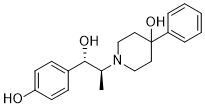
| 规格 | 价格 | 库存 | 数量 |
|---|---|---|---|
| 10mg |
|
||
| 25mg |
|
||
| 50mg |
|
||
| 100mg |
|
||
| 250mg |
|
||
| 500mg |
|
||
| Other Sizes |
|
| 靶点 |
NMDA Receptor
|
|---|---|
| 体外研究 (In Vitro) |
(1S,2S)-1-(4-羟基苯基)-2-(4-羟基-4-苯基哌啶基)-1-丙醇(20,CP-101606)是一种有效的选择性N-甲基-D-天冬氨酸(NMDA)拮抗剂。本报告中探索的苏二烷基骨架上的位点包括侧基甲基(H、甲基和乙基几乎相等;丙基弱得多)、连接C-4苯基和哌啶环的间隔基(一种具有0和2个碳原子的交替效力模式,产生最大效力)和简单的苯基取代(影响很小)。虽然通过双原子间隔物获得了强效的NMDA拮抗剂,但这种排列也增加了α1肾上腺素能亲和力。在这些哌啶环的C-4位置引入羟基导致α1肾上腺素能亲和力大幅降低。这些观察结果的结合对20的发现起到了重要作用。该化合物能有效保护培养的海马神经元免受谷氨酸毒性(IC50=10 nM),同时几乎不具有伊芬普利不希望的α1肾上腺素能亲和力(IC50约为20微M)。此外,20似乎缺乏非选择性竞争性和通道阻断性NMDA拮抗剂的精神运动兴奋作用。因此,20显示出作为神经保护剂的巨大前景,并且可能缺乏目前临床试验中化合物的副作用[1]。
|
| 体内研究 (In Vivo) |
Traxoprodil (20 nM icv) 增加 PTZ (70 mg/kg; ip) 诱导的全身强直破伤风; Traxoprodil(60 mg/kg,煤)延长了强直恢复和饱腹感的潜在时间,并减少了总预期受益时间[3]。 Traxoprodil 在 20 和 40 mg/kg 剂量的强迫游泳试验中表现出抗抑郁活性,并且与动物运动的变化相关 [2]。
多胺,包括亚精胺,通过积极调节N-甲基-d-天冬氨酸受体(NMDAr)促进癫痫发作。尽管NMDAr拮抗剂可以减少癫痫发作,但仍有待确定的是,NMDAr NR2B亚基的选择性拮抗剂曲索地尔是否会减少癫痫发作以及亚精胺是否会促进戊四唑(PTZ)诱导的癫痫发作。成年雄性Wistar大鼠侧脑室注射0.9%氯化钠(1μl,i.c.v.)、亚精胺(0.02、0.2或2nmol/位点,i.c.v)或曲索地尔(0.2、2或20nmol,i.c.v.)和PTZ(35或70mg/kg,i.p.)。还研究了口服曲索地尔(60mg/kg,口服)对癫痫发作的影响。通过行为和电图方法(EEG)记录阵挛性和全身性癫痫发作的潜伏期以及癫痫发作的总时间。亚精胺(2nmol/位点;i.c.v.)有助于亚阈值剂量的PTZ(35mg/kg;i.p.)诱导的癫痫发作,但不会改变抽搐剂量PTZ(70mg/kg;i.p..)诱导的发作活动。Traxoprodil(20nmol i.c.v.)增加了PTZ(70mg/kg;i.p.)诱导的全身强直-阵挛发作的潜伏期。Traxoprodil(60mg/kg,口服)增加了阵挛性和全身性癫痫发作的潜伏期,并减少了癫痫发作的总时间。这些结果支持NR2B亚基在PTZ诱导的癫痫发作中的作用。[2] |
| 动物实验 |
Traxoprodil (5, 10, 20, and 40 mg/kg) was suspended in a 1 % aqueous solution of Tween 80 (POCH), whereas imipramine hydrochloride (15 and 30 mg/kg), fluoxetine hydrochloride (5 mg/kg), escitalopram oxalate (2 mg/kg), reboxetine mesylate (2.5 mg/kg), WAY 100,635 (0.1 mg/kg), and ritanserin (4 mg/kgh) were dissolved in physiological saline (0.9 % NaCl). The solutions/suspension were prepared immediately prior to the experiments and were administered intraperitoneally (i.p.) 60 min before testing. The doses and pretreatment schedules were selected on the basis of the literature data and the results of our previous experiments (Poleszak et al. 2005, 2007a, 2011, 2013; Szewczyk et al. 2002, 2009). Animals from the control groups received i.p. injections of the vehicle (saline). The volume of all administered solutions/suspension was 10 ml/kg.[2]
|
| 药代性质 (ADME/PK) |
Metabolism / Metabolites
Traxoprodil has known human metabolites that include 4-[1-Hydroxy-2-(4-hydroxy-4-phenylpiperidin-1-yl)propyl]benzene-1,2-diol. |
| 参考文献 | |
| 其他信息 |
Metabolism / Metabolites:
Traxoprodil has known human metabolites that include 4-[1-Hydroxy-2-(4-hydroxy-4-phenylpiperidin-1-yl)propyl]benzene-1,2-diol.
One of the newest substances, whose antidepressant activity was shown is traxoprodil, which is a selective antagonist of the NR2B subunit of the NMDA receptor. The main goal of the present study was to evaluate the effect of traxoprodil on animals' behavior using the forced swim test (FST), as well as the effect of traxoprodil (10 mg/kg) on the activity of antidepressants, such as imipramine (15 mg/kg), fluoxetine (5 mg/kg), escitalopram (2 mg/kg) and reboxetine (2.5 mg/kg). Serotonergic lesion and experiment using the selective agonists of serotonin receptors 5-HT1A and 5-HT2 was conducted to evaluate the role of the serotonergic system in the antidepressant action of traxoprodil. Brain concentrations of tested agents were determined using HPLC. The results showed that traxoprodil at a dose of 20 and 40 mg/kg exhibited antidepressant activity in the FST and it was not related to changes in animals' locomotor activity. Co-administration of traxoprodil with imipramine, fluoxetine or escitalopram, each in subtherapeutic doses, significantly affected the animals' behavior in the FST and, what is important, these changes were not due to the severity of locomotor activity. The observed effect of traxoprodil is only partially associated with serotonergic system and is independent of the effect on the 5-HT1A and 5-HT2 serotonin receptors. The results of an attempt to assess the nature of the interaction between traxoprodil and the tested drugs show that in the case of joint administration of traxoprodil and fluoxetine, imipramine or escitalopram, there were interactions in the pharmacokinetic phase.[2] |
| 分子式 |
C20H25NO3
|
|---|---|
| 分子量 |
327.4174
|
| 精确质量 |
327.183
|
| 元素分析 |
C, 73.37; H, 7.70; N, 4.28; O, 14.66
|
| CAS号 |
134234-12-1
|
| 相关CAS号 |
Traxoprodil mesylate;188591-67-5
|
| PubChem CID |
219101
|
| 外观&性状 |
White to off-white solid powder
|
| 密度 |
1.2±0.1 g/cm3
|
| 沸点 |
534.4±50.0 °C at 760 mmHg
|
| 闪点 |
290.3±28.8 °C
|
| 蒸汽压 |
0.0±1.5 mmHg at 25°C
|
| 折射率 |
1.626
|
| LogP |
1.75
|
| tPSA |
63.93
|
| 氢键供体(HBD)数目 |
3
|
| 氢键受体(HBA)数目 |
4
|
| 可旋转键数目(RBC) |
4
|
| 重原子数目 |
24
|
| 分子复杂度/Complexity |
380
|
| 定义原子立体中心数目 |
2
|
| SMILES |
C[C@@H]([C@H](C1=CC=C(C=C1)O)O)N2CCC(CC2)(C3=CC=CC=C3)O
|
| InChi Key |
QEMSVZNTSXPFJA-HNAYVOBHSA-N
|
| InChi Code |
InChI=1S/C20H25NO3/c1-15(19(23)16-7-9-18(22)10-8-16)21-13-11-20(24,12-14-21)17-5-3-2-4-6-17/h2-10,15,19,22-24H,11-14H2,1H3/t15-,19+/m0/s1
|
| 化学名 |
1-((1S,2S)-1-hydroxy-1-(4-hydroxyphenyl)propan-2-yl)-4-phenylpiperidin-4-ol
|
| 别名 |
CP-101606; CP-98113; CP101606; 1-((1S,2S)-1-hydroxy-1-(4-hydroxyphenyl)propan-2-yl)-4-phenylpiperidin-4-ol; CP-101,606; Traxoprodil [INN]; CP98113; CP 101606; CP101,606; CP 98113.
|
| HS Tariff Code |
2934.99.9001
|
| 存储方式 |
Powder -20°C 3 years 4°C 2 years In solvent -80°C 6 months -20°C 1 month |
| 运输条件 |
Room temperature (This product is stable at ambient temperature for a few days during ordinary shipping and time spent in Customs)
|
| 溶解度 (体外实验) |
DMSO : ~62.5 mg/mL (~190.89 mM)
H2O : ~0.1 mg/mL (~0.31 mM) |
|---|---|
| 溶解度 (体内实验) |
配方 1 中的溶解度: ≥ 2.08 mg/mL (6.35 mM) (饱和度未知) in 10% DMSO + 40% PEG300 + 5% Tween80 + 45% Saline (这些助溶剂从左到右依次添加,逐一添加), 澄清溶液。
例如,若需制备1 mL的工作液,可将100 μL 20.8 mg/mL澄清DMSO储备液加入400 μL PEG300中,混匀;然后向上述溶液中加入50 μL Tween-80,混匀;加入450 μL生理盐水定容至1 mL。 *生理盐水的制备:将 0.9 g 氯化钠溶解在 100 mL ddH₂O中,得到澄清溶液。 配方 2 中的溶解度: ≥ 2.08 mg/mL (6.35 mM) (饱和度未知) in 10% DMSO + 90% (20% SBE-β-CD in Saline) (这些助溶剂从左到右依次添加,逐一添加), 澄清溶液。 例如,若需制备1 mL的工作液,可将 100 μL 20.8 mg/mL澄清DMSO储备液加入900 μL 20% SBE-β-CD生理盐水溶液中,混匀。 *20% SBE-β-CD 生理盐水溶液的制备(4°C,1 周):将 2 g SBE-β-CD 溶解于 10 mL 生理盐水中,得到澄清溶液。 View More
配方 3 中的溶解度: ≥ 2.08 mg/mL (6.35 mM) (饱和度未知) in 10% DMSO + 90% Corn Oil (这些助溶剂从左到右依次添加,逐一添加), 澄清溶液。 1、请先配制澄清的储备液(如:用DMSO配置50 或 100 mg/mL母液(储备液)); 2、取适量母液,按从左到右的顺序依次添加助溶剂,澄清后再加入下一助溶剂。以 下列配方为例说明 (注意此配方只用于说明,并不一定代表此产品 的实际溶解配方): 10% DMSO → 40% PEG300 → 5% Tween-80 → 45% ddH2O (或 saline); 假设最终工作液的体积为 1 mL, 浓度为5 mg/mL: 取 100 μL 50 mg/mL 的澄清 DMSO 储备液加到 400 μL PEG300 中,混合均匀/澄清;向上述体系中加入50 μL Tween-80,混合均匀/澄清;然后继续加入450 μL ddH2O (或 saline)定容至 1 mL; 3、溶剂前显示的百分比是指该溶剂在最终溶液/工作液中的体积所占比例; 4、 如产品在配制过程中出现沉淀/析出,可通过加热(≤50℃)或超声的方式助溶; 5、为保证最佳实验结果,工作液请现配现用! 6、如不确定怎么将母液配置成体内动物实验的工作液,请查看说明书或联系我们; 7、 以上所有助溶剂都可在 Invivochem.cn网站购买。 |
| 制备储备液 | 1 mg | 5 mg | 10 mg | |
| 1 mM | 3.0542 mL | 15.2709 mL | 30.5418 mL | |
| 5 mM | 0.6108 mL | 3.0542 mL | 6.1084 mL | |
| 10 mM | 0.3054 mL | 1.5271 mL | 3.0542 mL |
1、根据实验需要选择合适的溶剂配制储备液 (母液):对于大多数产品,InvivoChem推荐用DMSO配置母液 (比如:5、10、20mM或者10、20、50 mg/mL浓度),个别水溶性高的产品可直接溶于水。产品在DMSO 、水或其他溶剂中的具体溶解度详见上”溶解度 (体外)”部分;
2、如果您找不到您想要的溶解度信息,或者很难将产品溶解在溶液中,请联系我们;
3、建议使用下列计算器进行相关计算(摩尔浓度计算器、稀释计算器、分子量计算器、重组计算器等);
4、母液配好之后,将其分装到常规用量,并储存在-20°C或-80°C,尽量减少反复冻融循环。
计算结果:
工作液浓度: mg/mL;
DMSO母液配制方法: mg 药物溶于 μL DMSO溶液(母液浓度 mg/mL)。如该浓度超过该批次药物DMSO溶解度,请首先与我们联系。
体内配方配制方法:取 μL DMSO母液,加入 μL PEG300,混匀澄清后加入μL Tween 80,混匀澄清后加入 μL ddH2O,混匀澄清。
(1) 请确保溶液澄清之后,再加入下一种溶剂 (助溶剂) 。可利用涡旋、超声或水浴加热等方法助溶;
(2) 一定要按顺序加入溶剂 (助溶剂) 。